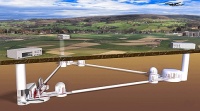The €790m (£688m) Einstein Telescope should be completed by 2025, by which time it will be capable of detecting gravitational waves around 100 orders of magnitude fainter than current devices can.
Gravitational waves have recently been studied and characterised by Nasa’s Gravity Probe B and ESA’s GOCE satellites. However, these were focused on the Earth’s gravitational field and how it warps space and time locally — the Einstein telescope will look for faint ripples of gravitational waves from violent events in the distant universe.
‘Many people think gravity is only a local force, but it’s quite the opposite, in fact — in terms of range, gravity is the force with the longest reach, but it is also the weakest and that’s one of the questions that’s still under debate — why should this be?,’ said Andreas Freise of Birmingham University, who is leading the optical design of the telescope.
To detect such faint gravitational waves the Einstein Telescope will use a so-called next-generation interferometer design.
Interferometers work by splitting a laser beam into two streams that then bounce off test masses at the end of each stream and return to their starting point, where they interfere with one another. Any passing gravitational wave will make one arm slightly longer and the other slightly shorter, thereby changing the interference pattern in a measurable way.
‘The effect is very similar to if you were to float two corks in water and you measured the distance between the corks when a wave passes,’ Freise said.
The Einstein Telescope aims to be able to detect gravitational waves from 2 to 40Hz, for which it will have to be built underground at a depth of about 100–200m.
‘The trick is you have to isolate it from any local disturbances, [such as] the earth shaking from small seismic events, from people passing by and electromagnetic disturbances,’ Freise said.
The Einstein Telescope is a European Framework Programme (FP7) with eight institutional partners, including three from the UK with Birmingham, Cardiff and Glasgow universities.



Project to investigate hybrid approach to titanium manufacturing
What is this a hybrid of? Superplastic forming tends to be performed slowly as otherwise the behaviour is the hot creep that typifies hot...